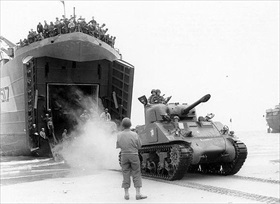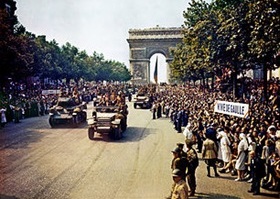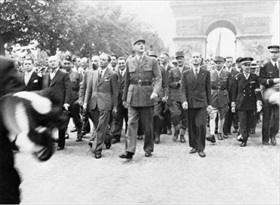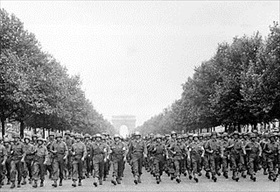CHURCHILL-DE GAULLE RIFT ON EVE OF D-DAY
London, England • June 2, 1944
In June 1943 in Algeria, North Africa, the Free French founded the Comité Français de Libération Nationale (CFNL). Much political maneuvering was needed to merge the Free French, whose nucleus consisted of Frenchmen who had escaped German capture at Dunkirk, the Channel port in Northwestern France (May 26 to June 4, 1940), with politicians and armed forces from the French territories freed by the Allies. Rival leaders Gen. Charles de Gaulle and Gen. Henri Giraud agreed to share the presidency of the CFNL.
Days before the Normandy landings, the CFNL announced that it was to be known as the Gouvernement Provisoire de la République Française, with de Gaulle as its head. President Franklin D. Roosevelt, who thought de Gaulle had an oversized ego and saw him as a potential dictator once he was back on French soil, insisted that the Allies were not liberating France to put de Gaulle in power. “I am unable at this time,” he wrote British Prime Minister Winston Churchill, “to recognize any Government of France until the French people have an opportunity for a free choice of Government.” The year before, he and Churchill had privately mused about creating a temporary military government for France under a British or American general and continued to do so into the summer of 1944. (The military model would be used in 1945 in Germany.)
Churchill’s relationship with de Gaulle was only slightly warmer than FDR’s. (Roosevelt’s successor in office, Harry S. Truman, called de Gaulle an “SOB” for the way he had treated the president.) Anyway, on this date, June 2, 1944, the British prime minister sent two passenger aircraft and a personal emissary to Algiers to fly de Gaulle back to Britain. Churchill played on de Gaulle’s ego by having an RAF band play the “Marseillaise” as the general descended the plane’s steps. Churchill’s intention was to hand de Gaulle a script to read over the radio on D‑Day (le Jour J in French), but the general declined because it made no mention of his being the legitimate interim ruler of France and it instructed French people to obey Allied military authorities pending elections. Rejecting the role of stooge, de Gaulle exchanged hurtful words with Churchill. Only on August 1, 1944, did the Allies permit the Free French 2nd Armored Division under Gen. Philippe Leclerc to set foot on French soil in liberated Normandy. Fifteen days later the French First Army (then called French Army B) under Gen. Jean de Lattre de Tassigny participated in the Allied invasion of Southern France (Operation Dragoon).
In the meantime de Gaulle made a whirlwind visit to the city of Bayeux in Normandy, proclaiming Bayeux to be the capital of Free France and leaving his aide-de-camp to head the civil administration. It was only in October, after most of France had been liberated from the German occupiers, that Churchill and Roosevelt recognized de Gaulle’s “government” as the provisional government of France. Even in the absence of a free and fair national election that included the participation of a broad spectrum of French political thinking, the two English-speaking Allies could not ignore the obvious stature and genuine popularity de Gaulle enjoyed among the majority of French people. The wily Frenchman had indeed outsmarted les Anglo-Saxons.
![]()
Free French Return to France, August 1944
 |  |
Left: Christened Ile-de-France, a French Army M4 Sherman tank lands on Utah Beach in Normandy, August 2, 1944, just under two months since the initial D‑Day landings. Some 14,454 personnel and equipment from Gen. Philippe Leclerc’s 2nd Armored Division landed over the next few days. Leclerc juggled three roles: He was a subordinate divisional commander in an American army, he was the commander of a separate national (French) force, and he was Gen. Charles de Gaulle’s man on the scene.
![]()
Right: Leclerc’s 2nd Armored Division eventually led the drive toward Paris. A small advance party arrived at the Hôtel de Ville (city hall) late on August 24, 1944. The next day Gen. Philippe Leclerc with the rest of his French Armored Division, along with the U.S. 4th Division, entered the French capital, and the German military governor of Paris with his garrison of 5,000 mostly unenthusiastic men capitulated. (Some sporadic fighting continued for several days.) On August 26 a large victory parade took place along Paris’ main boulevard, the Champs Élysées, lined with jubilant crowds acclaiming Gen. Charles de Gaulle and the 2nd Armored Division the liberators of Paris. A sign in the crowd reads, “Viva de Gaulle.”
 |  |
Left: Unmissable owing to his immense height, stubborn French patriot and Resistance leader Gen. Charles de Gaulle, in the company of his entourage, set off on August 25, 1944, from the Arc de Triumphe down the Champs Élysées to Notre Dame Cathedral for a service of thanksgiving following the city’s liberation. Often during his triumphal walk, with thousands of people shouting “Vive de Gaulle,” the general raised his long arms above his head, turning left then right, as though offering grateful thanks. In a rousing speech inside the cathedral he averred to “Paris liberated by her own people.”
![]()
Right: A combined Franco-American military parade was hastily organized on August 29, 1944, which featured Maj. Gen. Norman D. Cota’s 28th Infantry Division marching down the Champs Élysées a little over a month after it stepped ashore on Normandy’s beaches. After enjoying a respite, the division headed east to the German defensive Siegfried Line (Westwall), where it was the first of the Allied armies to reach German soil. Taking costly casualties during the ill-conceived Battle of the Huertgen Forest (beginning mid-September 1944) and the Battle of the Bulge (mid-December 1944 to late January 1945), the division memorably distinguished itself by impeding German advances in the Ardennes Forest in late December 1944, affording time for the Allies to organize the heroic defense of Bastonge in Belgium.
Contemporary American Newsreel of Liberation of Paris, August 1944
![]()

 History buffs, there is good news! The Daily Chronicles of World War II is now available as an ebook for $4.99 on Amazon.com. Containing a year’s worth of dated entries from this website, the ebook brings the story of this tumultuous era to life in a compelling, authoritative, and succinct manner. Featuring inventive navigation aids, the ebook enables readers to instantly move forward or backward by month and date to different dated entries. Simple and elegant! Click
History buffs, there is good news! The Daily Chronicles of World War II is now available as an ebook for $4.99 on Amazon.com. Containing a year’s worth of dated entries from this website, the ebook brings the story of this tumultuous era to life in a compelling, authoritative, and succinct manner. Featuring inventive navigation aids, the ebook enables readers to instantly move forward or backward by month and date to different dated entries. Simple and elegant! Click 











